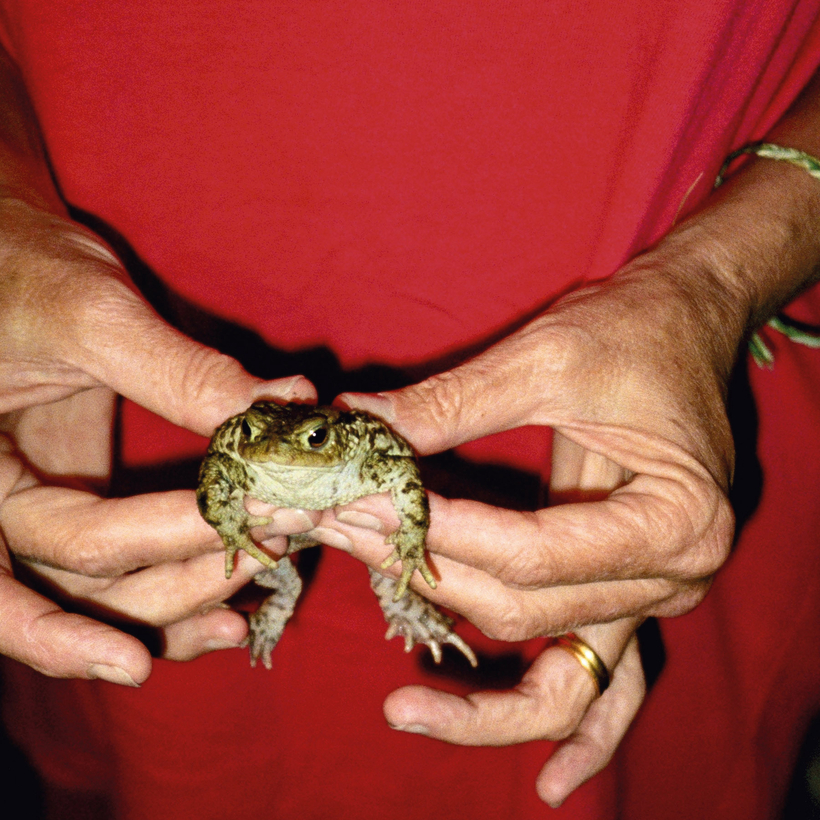Behind Mary McCartney, there’s a huge picture of a frog. It was taken in 1995, when McCartney was out walking one evening with her mother, Linda. Worried that the poor thing might get squashed on the path (“We’re a family of vegetarians—animal-lovers!”), Linda bent down to pick up the amphibian and move it to safety. Then, mid-maneuver, with the animal wearing an expression of almost saintly indifference, McCartney took a high-flash photograph on her point-and-shoot camera.

“I love it, because it’s of my mother’s hands,” McCartney says of the picture, shown this month at Sotheby’s London alongside 27 other images from her personal archive. Linda was a photographer, too, the matriarch of a creative clan that spans McCartney’s father, Paul, and her sisters Stella, the fashion designer, and Heather, the potter.
McCartney’s previous work has been inspired, in part, by the aesthetic legacy of her parents—notably a documentary, released last year, about Abbey Road Studios in her native London, where her father’s best-known work was honed. McCartney has said that she decided to pursue the project after discovering an old photograph, taken in 1977, of the pair walking across a road near the studio, with Linda’s pet pony trotting behind. “There’s an homage to her. She’s my inspiration,” McCartney told People magazine of the way her mother is weaved through the work.

“She was very elegant. I remember just looking at her hands a lot growing up as she handled the camera.” There’s a technique to picking up a frog, McCartney tells me, over a video call from her studio. “You have to be gentle with it, but firm. You don’t want it to wriggle away and injure itself more. So the picture’s about safety and kindness, but also about my mother. I mean, I could go on about it for hours … ”
This, I suspect, is largely the intention of the exhibition, titled “Can We Have a Moment?” It’s a series of little rabbit holes to get lost down—each personal and intimate to McCartney but just anonymous enough that we can beam our own lives and memories onto it. When I first saw Gently Holding Frog, I thought instinctively of my own mother, and her gold wedding ring and the tanned crevices and liver spots of her hands, and then I wanted to call her up, too.
When McCartney was delving into her archive—a vast collection of mainly analogue shots spanning 30 years—she found some pictures to be unexpectedly poignant. Mum’s Side of the Bed, taken in 1996, two years before Linda died of cancer, was a “very personal, very emotional image” to revisit.

“I was having tea in bed with my mum, and she got up. And that was her side of the bed, and the light sort of shone in at that moment,” McCartney says. “It’s sort of like a landscape to me, with all of the creases and shadows in the bedding. There’s a weightiness to it—you can really feel the presence of her without seeing her,” she continues. “You might sort of lose people, but you can still feel their presence.”
“I love it, because it’s of my mother’s hands.”
“There’s something about beds,” continues McCartney. “They’re very, very personal. There’s a shot of Lucian Freud’s bed in the exhibition, too, that very famous iron bed in his studio.” Tracey Emin—whose breakthrough, Turner Prize–nominated work was of her own booze-soaked bed—is photographed in the year 2000, with Emin sitting up against a headboard, dressed as a latter-day Frida Kahlo. “I’d never met her, and I got an e-mail address for her and asked if she would pose for me. I expected her to come back and say, ‘No way.’ But I was surprised that she loved the idea.”

This, McCartney says, is the spontaneous, peripatetic power of the camera. You show up, ask to take someone’s photo, and see where the whole thing takes you. “It’s got a sense of adventure, I think,” McCartney says. That might mean an unprecedented sortie behind the scenes with the Royal Ballet, where McCartney once slept alongside the dancers on a spare bed, resulting in perhaps the most intimate and innocent photographs in the exhibition. (“There was so much trust,” she says.) Or perhaps a journey into the depths of some dark, fairy-tale forest, capturing an elusive white stallion, shimmering and mythical in the ray of the flashbulb.
In their eclectic nature and generosity, the photographs almost seem to be of a different age—just a few years gone—where a camera was not the norm but the exception, and where we didn’t take photos to show off our own lives but to illuminate other peoples’. In that light, “Can We Have a Moment?” is a plea as much as it is a title.

McCartney’s particular vehicle for these escapes has long been Linda’s old Leica R7, on which the majority of the shots in the exhibition were taken—another neat way that the presence of her mother runs through the work—and a callback to the empty-bed picture she describes. “It’s like an adventure,” McCartney says of the Leica. “And it’s like I hold her with me.” As gently and as firmly, perhaps, as a frog.
“Can We Have A Moment” by Mary McCartney is online at Sothebys until June 9
Joseph Bullmore is a Writer at Large for AIR MAIL and the editor of Gentleman’s Journal in London

